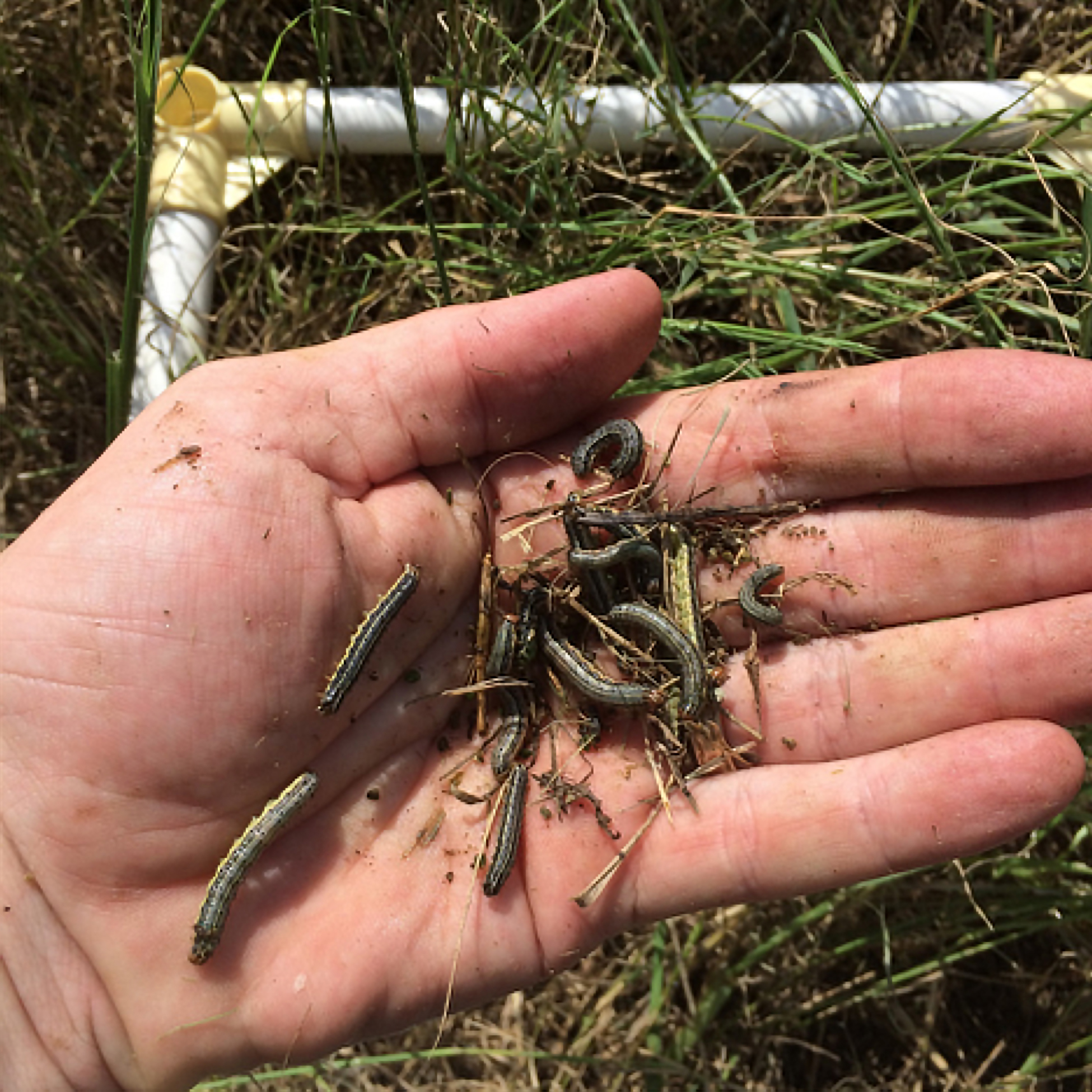Longer-lasting residuals give more economical fall armyworm management option
By Mary Hightower
U of A System Division of Agriculture
Fast facts
- 10-county demonstration shows effectiveness of longer lasting pest control
- Though more expensive, longer-lasting residuals more economical in the long run
- Don’t let guard down, October is still armyworm month
(670 words)
(Newsrooms: with art at https://flic.kr/p/MJYNz1)
FAYETTEVILLE, Ark. – Disappearing lawns, pastures and hay meadows are the calling card of grass-hungry fall armyworms and this year, a 10-county demonstration by the Cooperative Extension Service pointed to a more economical way to manage this annual pest.
“2016 has been a record year for fall armyworms, an estimated 300,000 – 500,000 acres of bermudagrass pasture or hay was infested,” said Kelly Loftin, extension entomologist for the University of Arkansas System Division of Agriculture. “Hay producers and homeowners began battling this pest in bermudagrass yards and hayfields as early as mid-June – at least three weeks earlier than normal.”

Loftin said that “county agricultural agents estimated that an average of 60 percent of bermudagrass was infested in the harder-hit counties.”
The demonstration in Perry, Yell, Izard, Cleburne, Pulaski, Pope, Sharp, Grant, Hot Spring and Miller counties compared a generic pyrethroid insecticide, lambdacyhalothrin, against two products with longer residual activity, known commercially as Besiege® and Intrepid®. Besiege is a pyrethroid with chlorantraniliprole, a residual with staying power, and Intrepid is the growth regulator methoxyfenozide.
In each of the counties, a two-acre strip of bermudagrass pasture or hayfield was sprayed with the pyrethroid and another two-acre strip was sprayed with either Besiege or Intrepid.
All fields in the demonstration averaged six worms per square foot, double the treatment threshold of three worms per square foot.
“All of the treatments killed worms in the field, however, a couple of the demonstration sites were re-infested,” said Hank Chaney, extension agricultural and natural resources educator for the Division of Agriculture, said. “In one demonstration, the pyrethroid-only strip was re-infested five days after treatment, but not the Besiege strip. In yet another demonstration, armyworms re-infested the pyrethroid strip 25 days after treatment, but did not re-infest the Besiege strip.”
“With an armyworm infestation like this summer’s, farmers should look at longer-lasting products to avoid having to spray three or more times with short residual insecticides,” said Joe Moore, Sharp County extension staff chair for the University of Arkansas System Division of Agriculture. “If a farmer can save a couple of insecticide applications, the added cost of insecticide with more residual activity would be offset by the additional application costs – diesel, tractor wear and tear.”
The bottom line
Loftin said the generic pyrethroid will cost about $3-$3.25 per acre, while the longer-lasting products run $12-$13 an acre. Plus there’s the cost of labor and diesel to run the sprayer – and that is calculated at about $5 an acre.
“Using these figures, the cost of three applications of lambdacyhalothrin is estimated at about $25 per acre. In comparison, the estimated cost of one application of Besiege® or Intrepid® is estimated at $17-$18 per acre,” he said.
Proper technique counts
Improper application or application equipment can lessen the effectiveness of an insecticide application, Loftin said.
“The best type of ground equipment to apply insecticides for armyworm control is a properly calibrated boom sprayer. If a boom sprayer is not available or terrain too steep, a properly calibrated cluster nozzle – or boomless -- sprayer can be used but only if it has a consistent spray distribution along the entire swath width.
“In general, the absolute minimum spray solution volume per acre is 10 gallons,” he said. “Higher volumes of spray solution usually result in better and more even coverage, especially with boomless sprayers.”
Gone, but not forgotten
In many areas fall armyworm infestations have subsided because of the drier conditions in September and early October.
“Although we may be enjoying a sigh of relief, farmers should not let their guard down just yet,” Loftin said. “Fall armyworms could be around until colder weather hits, at least through October or later.”
Loftin said fall is the time many are planting cool-season annuals such as winter wheat, annual ryegrass, rye or oats for cool-season grazing.
“These grasses are susceptible to fall armyworm attack and when heavily infested, the stand can be greatly reduced or lost,” he said. “Loss of wildlife food plots planted in cool-season annuals have already occurred in some locations.”
Mention of brand name products does not imply endorsement by the University of Arkansas System Division of Agriculture.
To learn more about pest management, contact your county extension office, or visit www.uaex.uada.edu.
Pursuant to 7 CFR § 15.3, the University of Arkansas System Division of Agriculture offers all its Extension and Research programs and services (including employment) without regard to race, color, sex, national origin, religion, age, disability, marital or veteran status, genetic information, sexual preference, pregnancy or any other legally protected status, and is an equal opportunity institution.
# # #
Media Contact: Mary Hightower
Dir. of Communication Services
U of A Division of Agriculture
Cooperative Extension Service
(501) 671-2126
mhightower@uada.edu
Related Links